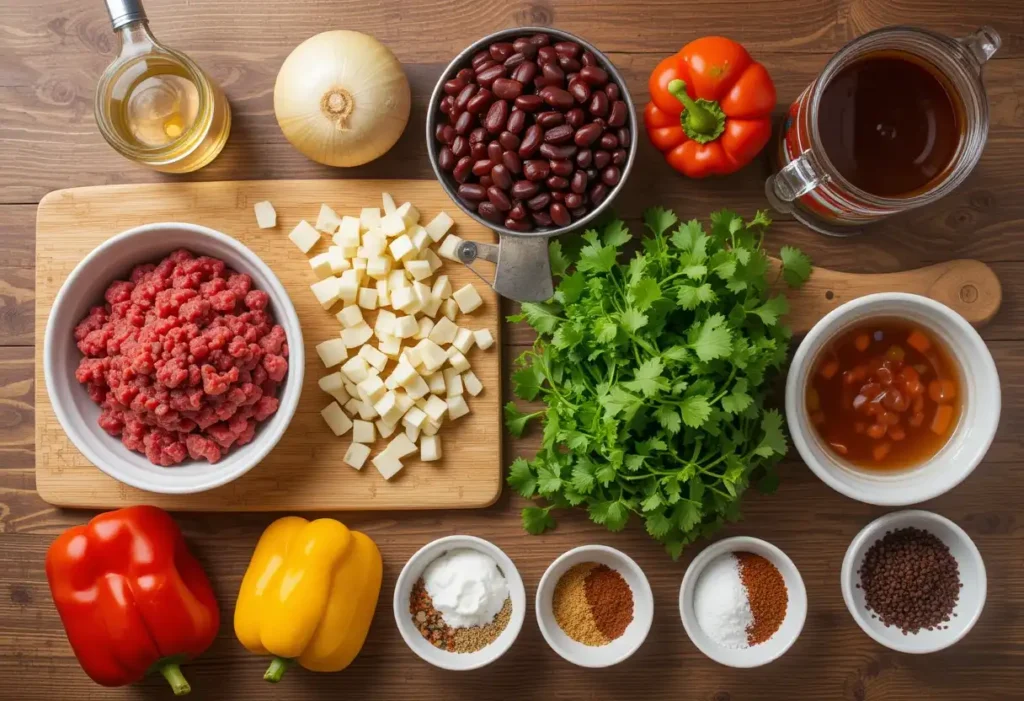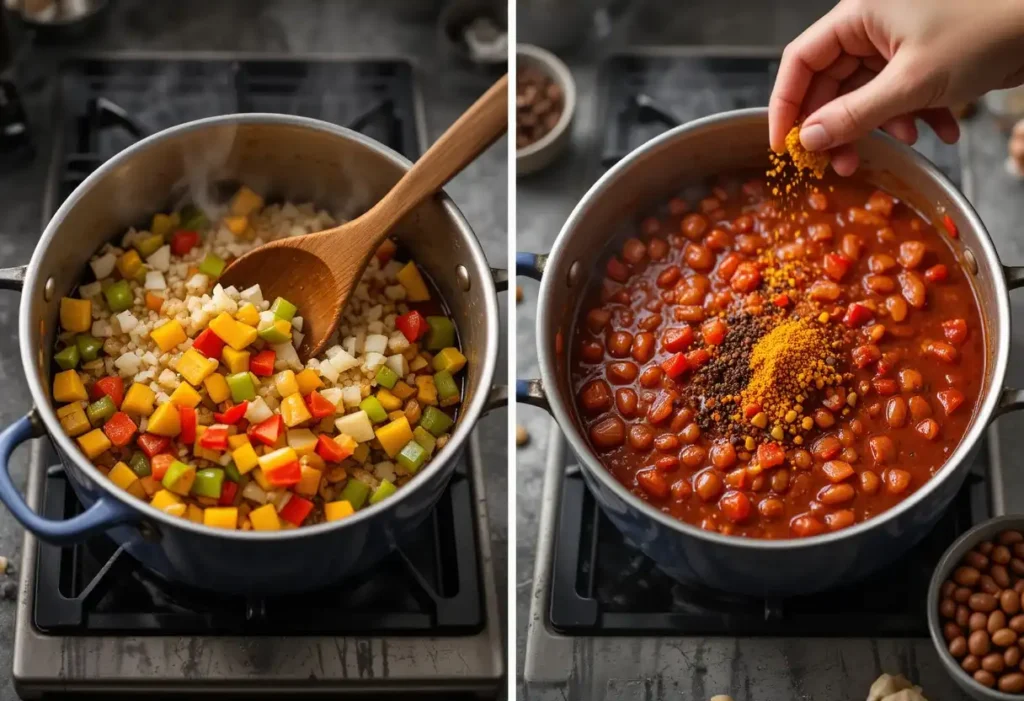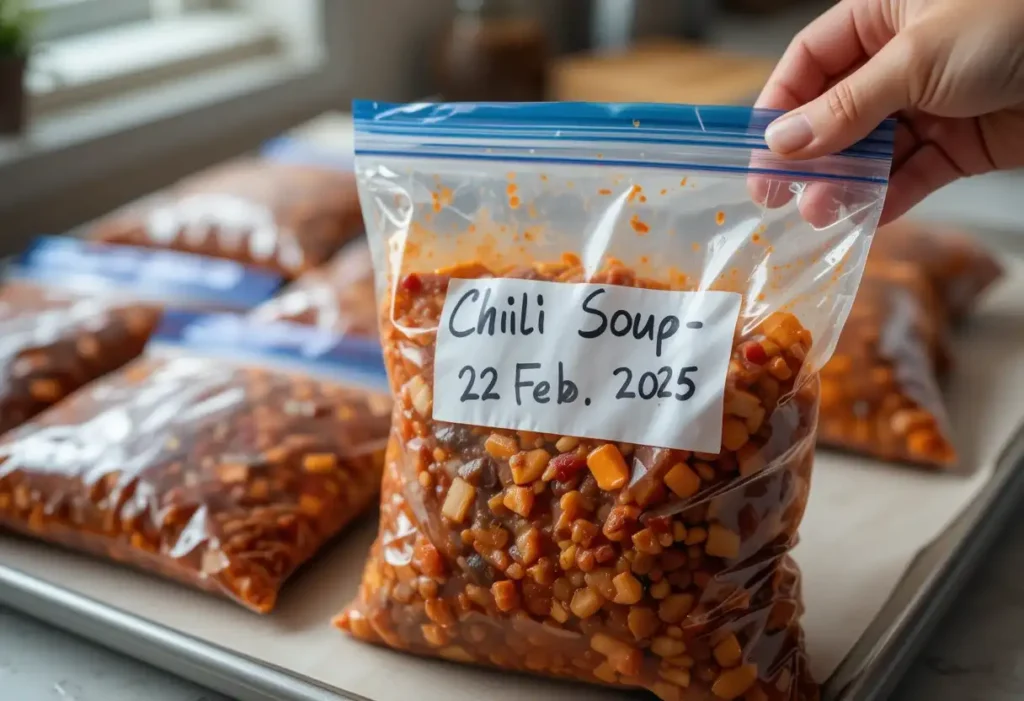There’s something magical about a steaming bowl of chili soup. It’s the kind of dish that wraps you in warmth, like an old friend on a chilly evening. Whether it’s simmering away on a stovetop in a cozy kitchen or being served up at a backyard gathering, chili soup has a way of bringing people together.
Everyone has their own version—some like it blazing hot with fiery peppers, while others keep it mellow and rich. Some swear by a meaty, slow-cooked pot, while others craft a hearty vegetarian blend bursting with beans and spices. No two bowls are ever quite the same, and that’s the beauty of it. Chili soup isn’t just a recipe—it’s a canvas, a tradition, and a taste of home, no matter where you are.
Table of Contents
What is Chili Soup?
Chili soup is a versatile and satisfying dish made with a blend of elements such as beans, tomatoes, peppers, and a variety of spices. It often includes meat like ground beef or turkey but can easily be adapted to vegetarian or vegan diets. The soup’s rich and hearty texture, combined with its bold flavors, makes it a staple in many households, particularly during colder months.
Today, chili soup is celebrated in cook-offs, community events, and family gatherings, symbolizing the shared love for its hearty and bold flavors.
Essential Ingredients for Chili Soup
Creating the perfect chili soup requires a careful balance of ingredients, each contributing to its rich flavor and hearty texture. While recipes may vary, certain key components are essential to crafting this iconic dish. Let’s dive into the primary ingredients, the role of spices, and optional additions that can elevate your soup to new heights.
Primary Components: Beans, Tomatoes, and Peppers
- Beans:
Beans are a cornerstone of chili soup, offering both nutrition and texture. Common varieties include:- Kidney Beans: Known for their meaty texture and ability to absorb flavors.Black Beans: Earthy and slightly sweet, these add depth to the dish.Pinto Beans: Creamy and mild, they blend seamlessly with other ingredients.
- Tomatoes:
Tomatoes form the acidic base of chili soup, providing a tangy and slightly sweet flavor. Ingredients such as:- Canned Diced Tomatoes (2-3 cups): A convenient option that blends easily.
- Tomato Paste (2-4 tablespoons): Adds richness and intensifies the flavor.
- Fresh Tomatoes (2-3 medium): Offer a fresher, lighter taste.
- Peppers:
Chili soup derives its signature kick from a variety of peppers:- Chili Peppers (1-2, finely chopped): For heat and bold flavor.
- Bell Peppers (1-2, diced): Add sweetness and balance.
- Jalapeños or Serrano Peppers (optional, 1-2): For those who prefer a spicier profile.
The Role of Spices in Elevating Chili Soup
Spices are the soul of chili soup, transforming basic ingredients into a symphony of flavors. The following spices are essential:
- Chili Powder (2-3 tablespoons): The heart of the dish, providing a smoky, slightly sweet heat.
- Cumin (1-2 teaspoons): Adds earthy warmth and depth.
- Paprika (1-2 teaspoons): Enhances color and offers a mild, sweet undertone.
- For a smoky version, opt for smoked paprika.
- Garlic Powder or Fresh Garlic (1-2 cloves or 1 teaspoon): Adds pungency and richness.
- Onion Powder or Fresh Onion (1 small onion, diced or 1 teaspoon): Balances the flavors.
- Salt and Black Pepper (to taste): The essential seasoning for all components.
- Cayenne Pepper (optional, a pinch to ½ teaspoon): For an extra layer of heat.
Spices are typically adjusted based on personal preference, allowing for a mild or fiery chili sou p.
Optional Additions for Unique Flavors
For those looking to personalize their chili sou p, consider the following optional ingredients:
- Proteins:
- Ground Beef, Turkey, or Chicken (1-2 pounds): For a meatier chili.
- Plant-Based Proteins (e.g., tofu crumbles or tempeh): For a vegetarian option.
- Vegetables:
- Corn Kernels (1 cup): Adds a touch of sweetness.
- Carrots or Celery (½ cup, diced): For added texture and subtle flavors.
- Sweeteners:
- Brown Sugar or Honey (1-2 teaspoons): Balances the acidity of tomatoes.
- Liquid Enhancements:
- Broth (Chicken, Beef, or Vegetable) (2-4 cups): Creates a more soup like consistency.
- Beer or Red Wine (¼-½ cup): Adds complexity and depth to the flavor profile.
- Herbs and Garnishes:
- Fresh Cilantro or Parsley (for garnish): Adds freshness.
- Lime Juice (1-2 teaspoons): Brightens the flavors.
By experimenting with these optional additions, you can craft a chili soup that’s uniquely yours, suited to your taste and preferences. From classic to creative, the possibilities are endless!
How to Make Chili Soup
Cooking chili soup is an enjoyable culinary adventure that allows for creativity while following a few basic principles. Below is a step by step guide to making classic chili soup, along with variations to suit different preferences and tips to avoid common pitfalls.
Step-by-Step Recipe for Classic Chili Soup
Ingredients:
- 1 lb ground beef or turkey (optional for vegetarian)
- 1 medium onion, diced
- 2-3 garlic cloves, minced
- 1-2 cups beans (kidney, black, or pinto)
- 2-3 cups canned diced tomatoes
- 2 tablespoons tomato paste
- 1-2 cups broth (chicken, beef, or vegetable)
- 1-2 bell peppers, diced
- 1-2 chili peppers, finely chopped
- 2 tablespoons chili powder
- 1 teaspoon cumin
- 1 teaspoon smoked paprika
- Salt and pepper to taste
- Optional toppings: shredded cheese, sour cream, fresh cilantro

Instructions:
- Prepare Ingredients: Chop vegetables, rinse beans, and measure spices.
- Sauté Aromatics: Heat 1-2 tablespoons of oil in a large pot. Add diced onion and garlic, cooking until fragrant (2-3 minutes).
- Cook Protein (if using): Add ground beef or turkey and cook until browned. Drain excess fat if necessary.
- Add Vegetables: Stir in bell peppers and chili peppers, cooking for another 3-4 minutes.
- Incorporate Tomatoes and Broth: Add canned tomatoes, tomato paste, and broth. Stir to combine.
- Season and Simmer: Add chili powder, cumin, smoked paprika, salt, and pepper. Bring to a boil, then reduce heat to low. Simmer uncovered for 20-30 minutes, stirring occasionally.
- Add Beans: Stir in beans during the last 10 minutes of cooking to heat through.
- Taste and Adjust: Adjust seasoning as needed. For thicker chili, simmer longer; for thinner soup, add more broth.
- Serve: Ladle into bowls and garnish with your choice of toppings.

Variations: Vegan, Spicy, and Meat Lover’s Chili
- Vegan Chili Soup:
- Replace meat with plant based proteins like tofu or tempeh.
- Add extra vegetables such as zucchini or mushrooms for bulk.
- Use vegetable broth for the base.
- Increase spices for a bold flavor profile.
- Spicy Chili Soup:
- Add extra chili peppers (e.g., jalapeños, serranos) or a dash of cayenne pepper.
- Incorporate chipotle in adobo sauce for a smoky, spicy kick.
- Serve with spicy salsa or hot sauce on the side.
- Meat Lover’s Chili:
- Use a combination of ground beef, sausage, or shredded chicken.
- Add cooked bacon pieces for a smoky touch.
- Use beef broth and consider adding a splash of Worcestershire sauce for depth.
Common Mistakes and How to Avoid Them
- Overcooking the Beans:
- Overcooked beans can become mushy. Add them during the last 10 minutes of cooking.
- Underseasoning:
- Taste and adjust spices as the soup cooks. Flavors develop over time, so don’t skimp on seasoning.
- Too Thick or Too Thin:
- If the soup is too thick, add more broth or water. If it’s too thin, simmer uncovered to reduce.
- Skipping Browning Steps:
- Browning meat and sautéing aromatics intensify flavors, so don’t rush this step.
- Ignoring Ingredient Balance:
- Avoid overloading on any one ingredient. Balance beans, vegetables, and broth for a cohesive dish.
- Burning Spices:
- Spices should be added early to bloom but not cooked on high heat, which can lead to bitterness.
By following these guidelines and experimenting with variations, you can master the art of chili soup and make every bowl a flavorful success!
Nutritional Value of Chili Soup
Chili soup is not only a flavorful dish but also a nutritional powerhouse, depending on the ingredients used. With a balance of proteins, fiber, and essential vitamins, it can be a wholesome addition to your diet.
Health Benefits of Key Ingredients
- Beans:
- Rich in fiber: Promotes digestive health and helps maintain steady blood sugar levels.
- High in protein: Supports muscle growth and repair.
- Packed with antioxidants: Protect cells from damage and reduce inflammation.
- Tomatoes:
- Source of vitamin C: Boosts the immune system.
- Contains lycopene: A powerful antioxidant linked to heart health and reduced cancer risk.
- Peppers:
- Provide capsaicin: Known for its anti inflammatory and metabolism boosting properties.
- High in vitamins A and C: Essential for skin health and immunity.
- Spices (e.g., chili powder, cumin, paprika):
- Have anti-inflammatory and antibacterial properties.
- Aid in digestion and enhance overall metabolism.
- Lean Protein (if added):
- Supplies essential amino acids for body repair and energy.
Chili soup can be a well-rounded meal that offers a variety of health benefits while being low in calories and high in satisfaction.
How to Adjust Chili Soup for Dietary Needs
- Low-Calorie Version:
- Use lean protein or skip the meat entirely.
- Opt for low-sodium broth and reduce added oils.
- Vegetarian/Vegan:
- Replace meat with tofu, tempeh, or extra beans.
- Use plant based broth and ensure no animal derived toppings (e.g., sour cream).
- Gluten-Free:
- Ensure all ingredients, including spices and broths, are certified gluten-free.
- Low-Carb/Keto:
- Skip beans and focus on low carb vegetables like zucchini, cauliflower, or spinach.
- Use ground beef or turkey as the primary protein source.
- High-Protein:
- Add extra beans, lean meats, or plant based protein options.
By tailoring the ingredients, chili soup can fit a wide range of dietary preferences and needs.
Tips for Storing and Reheating Chili Soup
Chili soup is an excellent make ahead meal that stores and reheats beautifully, often tasting better the next day as the flavors meld together.
The Best Way to Freeze Chili Soup
- Cool Completely:
- Allow the soup to cool to room temperature before freezing to prevent condensation and freezer burn.
- Use Airtight Containers:
- Store in freezer safe containers or resealable freezer bags. Leave a small gap for expansion.
- Portion Sizes:
- Divide into single serving portions for convenience.
- Label and Date:
- Clearly label containers with the type of soup and the freezing date to keep track.
- Freeze Flat (for bags):
- Lay freezer bags flat for space efficient storage.

Storage Duration: Chili soup can be stored in the freezer for up to 3 months.
Reheating Techniques to Retain Flavor
- Thaw Properly:
- Thaw frozen chili soup in the refrigerator overnight or use the defrost setting on your microwave.
- Stovetop Method:
- Heat on low to medium heat, stirring occasionally to ensure even warming. Add a splash of broth or water if the soup thickened during storage.
- Microwave Method:
- Heat in a microwave safe container, stirring halfway through to prevent cold spots. Cover loosely to avoid splatter.
- Avoid Overcooking:
- Reheat only until warm to preserve the texture of beans and vegetables.
- Enhance Flavors:
- Add fresh herbs or a dash of spices to revive the flavors if needed.
By following these storage and reheating tips, you can enjoy the same delicious, hearty chili soup even days or weeks after making it.
Frequently Asked Questions About Chili Soup
Chili soup is a favorite comfort food with endless variations, often inspiring questions from cooks of all levels. Below are some of the most common inquiries about preparing, serving, and storing this versatile dish.
What Makes a Great Chili Soup?
A great chili soup is defined by its balance of flavors and texture. Key elements include:
A rich base: Whether tomato based or broth based, the base should be flavorful and well seasoned.
Quality ingredients: Fresh vegetables, beans, and spices make a big difference.
The right spice level: Adjust chili peppers and spices to suit your preference for heat.
Proper cooking technique: Slow simmering allows flavors to meld and deepen, creating a more cohesive and satisfying dish.
Can Chili Soup Be Made Ahead of Time?
Yes, chili soup is an ideal make ahead dish. In fact, many people find it tastes even better the next day as the flavors have time to meld. To make ahead:
Cook the soup completely.
Allow it to cool to room temperature.
Store in an airtight container in the refrigerator for up to 3-4 days or freeze for longer storage.
Reheat gently on the stovetop or in the microw
How Do You Fix Overly Spicy Chili Soup?
If your chili soup turns out too spicy, there are several ways to tone down the heat:
Dilution: Add more broth, tomatoes, or beans to dilute the spiciness.
Dairy: Stir in sour cream, Greek yogurt, or shredded cheese to neutralize the heat.
Sweetness: Add a small amount of sugar, honey, or brown sugar to balance the spice.
Starch: Incorporate cooked rice, pasta, or potatoes to absorb some of the heat.
Acid: A squeeze of lime juice or a splash of vinegar can help balance the flavors.
What Are the Best Toppings for Chili Soup?
Toppings are a great way to add extra flavor and texture to chili sou p. Popular options include:
Cheese: Shredded cheddar, Monterey Jack, or crumbled queso fresco.
Dairy: Sour cream or plain Greek yogurt for creaminess.
Herbs: Fresh cilantro, parsley, or green onions for brightness.
Crunch: Crushed tortilla chips, cornbread croutons, or toasted pumpkin seeds.
Avocado: Sliced or diced avocado for richness.
Heat: A dash of hot sauce or sliced jalapeños for spice lovers.
How Long Can Chili Soup Be Stored Safely?
Refrigerator: The soup can be safely stored in the refrigerator for 3-4 days in an airtight container.
Freezer: When frozen properly, the soup can last up to 3 months. Be sure to label and date the container for easy reference.
Always reheat chili sou p to an internal temperature of 165°F (74°C) before consuming to ensure safety.
Can You Make Chili Soup Without Tomatoes?
Absolutely! While tomatoes are a common ingredient in chili soup, you can create a tomato-free version by:
Using a broth base: Substitute vegetable, chicken, or beef broth for tomatoes.
Adding creaminess: Use coconut milk or heavy cream for a rich and smooth texture.
Increasing spices: Add extra cumin, paprika, and chili powder for depth.
Incorporating vegetables: Use a combination of bell peppers, zucchini, and carrots for a hearty, tasty alternative.
Tomato-free chili soup is an excellent option for
Conclusion
Chili soup is a versatile and satisfying dish that can be tailored to suit any taste or dietary preference. With its rich history, essential ingredients, and endless variations, this guide equips you to craft your perfect bowl of chili sou p. Whether you’re a fan of traditional recipes or prefer to experiment with new flavors, chili soup remains a timeless comfort food.
For further culinary inspiration, explore other hearty and delicious recipes on Diversity Recipes. Try the Vegetarian Lasagna Soup for another warm and satisfying meal option. Looking for a creative dessert pairing? Check out Avocado Brownies for a healthy and indulgent treat. Or, add a savory twist to your menu with Mini Chicken Pot Pies.

